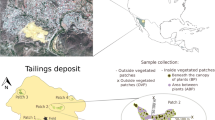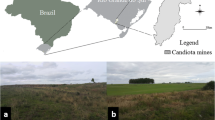Abstract
The ability of colonizer organisms to tolerate high metal concentrations is important to the restoration and rehabilitation of mining sites. We investigated colonization on modular cellular surfaces—artificial construction-niche—prepared by combining different proportions of iron mine tailings (8% tailing dam material), soil (90%), and cement (2%) through bioassays conducted under stable laboratory conditions of humidity, temperature, and light intensity. The establishment of microorganisms was measured using CO2-respirometry and microbiological assays. Sub-aerial communities grown on the experimental materials were composed of heterotrophic and phototrophic macro- and microorganisms. Four groups of phototrophic species were observed: cyanobacteria, algae, mosses, and ferns. The cyanobacteria comprised three genera: Phormidium sp., with branched filaments, Nostoc sp. and Pseudanabaena sp.; algae included Trentepohlia sp. (Chlorophyceae), a sub-aerial or terrestrial green algae. Macroscopic fungal hyphae were also observed. CO2 production occurred in all cellular modules due to the growth of bacteria, actinobacteria, and fungi. The presence of living organisms on these artificial construction-niche containing iron ore tailings was a promising finding as those colonizers could initiate the processes of primary succession and occupy significant portions of the sub-aerial surfaces, thus actively participating in weathering and soil formation to create new ecological niches for recuperating ironstone outcrop ecosystems.





Similar content being viewed by others
References
Agurto-Detzel H, Bianchi M, Assumpção M, Schimmel M, Collaço B, Ciardelli C, Barbosa JR, Calhau J (2016) The tailings dam failure of 5 November 2015 in SE Brazil and its preceding seismic sequence. Geophys Res Lett 43:4929–4936. doi:10.1002/2016GL069257
Alves RJV, Kolbek J (2010) Can campo rupestre vegetation be floristically delimited based on vascular plant genera? Plant Ecol 207:67–79. doi:10.1007/s11258-009-9654-8
Alves RJV, Cardin L, Kropf MS (2007) Angiosperm disjunction ‘‘campos rupestres-restingas’’: a re-evaluation. Acta Bot Bras 21:675–685. doi:10.1590/S0102-33062007000300014
Bartha R, Pramer D (1965) Features of a flask and method for measuring the persistence and biological effects of pesticides in soil. Soil Sci 100:68–70. doi:10.1097/00010694-196507000-00011
Bhatnagar A, Bhatnagar M (2005) Microbial diversity in desert ecosystems. Curr Sci 89:91–100
Boogert NJ, Paterson DM, Laland KN (2006) The implications of niche construction and ecosystem engineering for conservation biology. Bioscience 56:570–578. doi:10.1641/0006-3568(2006)56[570:TIONCA]2.0.CO;2
Brown GE, Trainor TP, Chaka AM (2008) Geochemistry of mineral surfaces and factors affecting their chemical reactivity. In: Nilsson A, Pettersson LGM, Norskov JK (eds) Chemical bonding at surfaces and interfaces. Elsevier, Amsterdam, pp 457–509
Chenu C, Stotzky G (2002) Interactions between microorganism and soil particles: an overview. In: Huang PM, Bollag J-M, Senesi N (eds) Interactions between soil particles and microorganisms: impact on the terrestrial ecosystem, vol 8. Wiley, Ltda, London, pp 3–41
Collard JM, Corbisier P, Diels L, Dong Q, Jeanthon C, Mergeay M, Taghavi S, Vad der Lelie D, Wilmotte A, Wuertz S (1994) Plasmids for heavy metal resistance in Alcaligenes eutrophus CH34: mechanisms and application. FEMS Microbiol Rev 14:405–414. doi:10.1111/j.1574-6976.1994.tb00115.x
Dallacort R, Lima Jr HC, Willrich FL, Barbosa NP (2002) Resistência à compressão do solo-cimento com substituição parcial do cimento Portland por resíduo cerâmico moído. Rev Bras Eng Agríc Ambient 6:511–518
Das S, Ram SS, Sahu HK, Rao DS, Chakraborty A, Sudarshan M, Thatoi HN (2013) A study on soil physico-chemical, microbial and metal content in Sukinda chromite mine of Odisha, India. Environ Earth Sci 69:2487–2497. doi:10.1007/s12665-012-2074-4
De Benites VM, Caiafa AN, de Mendonça ES, Schaefer CE, Ker JC (2003) Solos e vegetação nos complexos rupestres de altitude da Mantiqueira e do Espinhaço. Floresta Ambiente 10:76–85
De Benites VM, Schaefer CE, Simas FNB, Santos HG (2007) Soils associated with rock outcrops in the Brazilian mountain ranges Mantiqueira and Espinhaço. Rev Bras Bot 30:569–577. doi:10.1590/S0100-84042007000400003
DeJong JT, Fritzges MB, Nusstein K (2006) Microbially induced cementation to control sand response to undrained shear. J Geotech Geoenviron Eng 32:1381–1392. doi:10.1061/(ASCE)1090-0241(2006)132:11(1381)
Drummond GM, Martins CS, Machado ABM, Sebaio FA, Antonini Y (2005) Biodiversidade de Minas Gerais: um Atlas para sua Conservação, 2nd edn. Fundação Biodiversitas, Belo Horizonte, p 222
Edraki M, Baumgart T, Manlapig E, Bradshaw D, Franks DM, Moran CJ (2014) Designing mine tailings for better environmental, social and economic outcomes: a review of alternative approaches. J Clean Prod 84:411–420. doi:10.1016/j.jclepro.2014.04.079
Fernandes GW (2016) The megadiverse Rupestrian Grassland. In: Fernandes GW (ed) Ecology and conservation of mountaintop grasslands in Brazil, Chapter 1. Springer International Publishing, New York, pp 3–14. doi:10.1007/978-3-319-29808-5
Fernandes GW, Toma TSP, Angrisano P, Overbeck G (2016) Challenges in the restoration of quartzitic and ironstone Rupestrian Grasslands. In: Fernandes GW (ed) Ecology and conservation of mountaintop grasslands in Brazil, Chapter 19. Springer International Publishing, New York, pp 449–477. doi:10.1007/978-3-319-29808-5
Gadd GM (1990) Heavy metal accumulation by bacteria and other micro-organisms. Experentia 46:434–840. doi:10.1007/BF01935534
Gadd GM (2007) Geomycology: biogeochemical transformations of rocks, minerals, metals and radionuclides by fungi, bioweathering and bioremediation. Mycol Res 11:3–49
Gadd GM (2010) Metals, minerals and microbes: geomicrobiology and bioremediation. Microbiology 156:609–643. doi:10.1099/mic.0.037143-0
Gao K, Yu H, Brown MT (2007) Solar PAR and UV radiation affects the physiology and morphology of the cyanobacterium Anabaena sp. PCC 7120. J Photochem Photobiol B 89:117–124. doi:10.1016/j.jphotobiol.2007.09.006
Garcia LC, Barros FV, Lemos-Filho JP (2009) Fructification phenology as an important tool in the recovery of iron mining areas in Minas Gerais, Brazil. Braz J Biol 69:887–893. doi:10.1590/S1519-69842009000400017
García-Meza JV, Carrillo-Chávez A, Morton-Bermea O (2006) Sequential extractions on mine tailings samples alter and before bioassays: implications on the speciation of metals during microbial re-colonization. Environ Geol 49:437–448. doi:10.1007/s00254-005-0101A
Glasauer S, Langley S, Beveridge TJ (2001) Sorption of Fe (hydr)oxides to the surface of Shewanella putrefaciens: cell-bound fine-grained minerals are not always formed de novo. Appl Environ Microbiol 67:5544–5550. doi:10.1128/AEM.67.12.5544-5550.2001
Gorbushina AA (2007) Life on the rocks. Environ Microbiol 9:1613–1631. doi:10.1111/j.1462-2920.2007.01301.x
Gorbushina AA, Broughton WJ (2009) Microbiology of the atmosphere-rock interface: how biological interactions and physical stresses modulate a sophisticated microbial ecosystem. Annu Rev Microbiol 63:431–450. doi:10.1146/annurev.micro.091208.073349
Gorbushina AA, Petersen K (2000) Distribution of microorganisms on ancient wall paintings as related to associated faunal elements. Int Biodeterior Biodegrad 46:277–284. doi:10.1016/S0964-8305(00)00103-7
Grant C, Koch J (2007) Decommissioning Western Australia’s first bauxite mine: co-evolving vegetation restoration technique sand targets. Ecol Manag Restor 8:92–105. doi:10.1111/j.1442-8903.2007.00346.x
Guiry MD, Guiry GM (2013) Algae base. World-wide electronic publication, National University of Ireland, Galway. http://www.algaebase.org; searched on 08 May 2016
Hamdali H, Hafidi M, Virolle MJ, Ouhdouch Y (2008) Rock phosphate-solubilizing Actinomycetes: screening for plant growth-promoting. World J Microbiol Biotechnol 24:2565–2575. doi:10.1007/s11274-008-9817-0
Hamdali H, Moursalou K, Tchangbedji G, Ouhdouch Y, Hafidi M (2012) Isolation and characterization of rock phosphate solubilizing actinobacteria from a Togolese phosphate mine. Afr J Biotech 11:312–320. doi:10.5897/AJB11.774
Hochella MF (2002) Sustaining Earth: thoughts on the present and future roles in mineralogy in environmental science. Miner Mag 66:627–652. doi:10.1180/0026461026650053
Huang PM, Bollag JM, Senesi N (2002) Interactions between soil particles and microorganisms: impact on the terrestrial ecosystem. IUPAC series on analytical and physical chemistry of environmental systems, vol 8. Wiley, Chichester, p 566
Issa AA, Abd-Alla MH, Ohyama T (2014) Nitrogen fixing cyanobacteria: future prospect. In: Ohyama T (ed) Advances in biology and ecology of nitrogen fixation, chapter 2. InTech, Rijeka, pp 23–48. doi:10.5772/56995
Ivanov V, Chu J (2008) Applications of microorganisms to geotechnical engineering for bioclogging and biocementation of soil in situ. Rev Environ Sci Biotechnol 7:139–153. doi:10.1007/s11157-007-9126-3
Jacobi CM, do Carmo FF (2008) The contribution of ironstone outcrops to plant diversity in the Iron Quadrangle, a threatened Brazilian landscape. Ambio 37:324–326. doi:10.1579/0044-7447(2008)37[324:TCOIOT]2.0.CO;2
Jacobi CM, do Carmo FF, Vincent RC, Stehmann JR (2007) Plant communities on ironstone outcrops: a diverse and endangered Brazilian ecosystem. Biodivers Conserv 16:2185–2200. doi:10.1007/s10531-007-9156-8
Jacobi CM, do Carmo FF, de Campos IC (2011) Soaring extinction threats to endemic plants in Brazilian metal-rich regions. Ambio 40:540–543. doi:10.1007/s13280-011-0151-7
Jiang Y, Li WJ, Xu P, Tang SK, Xu LH (2005) Study on diversity of Actinomycetes salt and alkaline environments. Wei Sheng Wu Xue Bae 46:191–195
Jiang D, Huanga Q, Caib P, Rong X, Chena W (2007) Adsorption of Pseudomonas putida on clay minerals and iron oxide. Colloids Surf B 54:217–221. doi:10.1016/j.colsurfb.2006.10.030
Kalinowski BE, Liermann LJ, Givens S, Brantley SL (2000) Rates of bacteria-promoted solubilization of Fe from minerals: are view of problems and approaches. Chem Geol 169:357–370. doi:10.1016/S0009-2541(00)00214-X
Laland KN, O’Brien MJ (2010) Niche construction: theory and archaeology. J Archaeol Method Theory 17:303–322. doi:10.1007/s10816-010-9096-6
Lemes-da-Silva NM, Branco LHZ, Necchi-Júnior O (2012) Corticolous cyanobacteria from tropical forest remnants in northwestern São Paulo State, Brazil. Braz J Bot 35:169–179. doi:10.1590/S0100-84042012000200006
Liu G, Zhang Q, Zhu H, Hu Z (2012) Massive Trentepohlia-bloom in a glacier valley of Mt. Gongga, China, and a new variety of Trentepohlia (Chlorophyta). PLOS-ONE 7:e37725. doi:10.1371/journal.pone.0037725
Lottermoser BG (2011) Recycling, reuse and rehabilitation of mine wastes. Elements 7:405–410. doi:10.2113/gselements.7.6.405
Mager DM, Thomas AD (2011) Extracellular polysaccharides from cyanobacterial soil crusts: a review of their role in dryland soil processes. J Arid Environ 75:91–97. doi:10.1016/j.jaridenv.2010.10.001
Martin JP (1950) Use of acid, rose bengal and streptomycin in the plate method for estimating soil fungi. Soil Sci 69:215–233
Milani APS, Freire WJ (2006) Características físicas e mecânicas de misturas de solo, cimento e casca de arroz. Eng Agríc 26:1–10
NDMP - National Department of Mineral Production (2006) DNPM. Mineral summary 2006. DNPM, Brasilia
NDMP - National Department of Mineral Production (2010) DNPM. Mineral summary. Brasilia, DNPM
Pang J, Chan GSY, Zhang J, Liang J, Wong MH (2003) Physiological aspects of vetiver grass for rehabilitation in abandoned metalliferous mine wastes. Chemosphere 52:1559–1570. doi:10.1016/S0045-6535(03)00496-X
Pathom-Aree W, Stach JE, Ward AC, Horikoshi K, Bull AT, Goodfellow M (2006) Diversity of actinomycetes isolated from Challenger Deep sediment (10,898 m) from the Mariana Trench. Extremophiles 10:181–189. doi:10.1007/s00792-005-0482-z
Schaefer CEGR, Corrêa GR, Candido HG, Arruda DM, Nunes JA, Araujo RW, Rodrigues PMS, Fernandes-Filho EI, Pereira AFS, Brandão PC, Neri AV (2016) The physical environment of Rupestrian grasslands (Campos Rupestres) in Brazil: geological, geomorphological and pedological characteristics, and interplays. In: Fernandes GW (ed) Ecology and conservation of mountaintop grasslands in brazil, chapter 2. Springer International Publishing, New York, pp 15–53. doi:10.1007/978-3-319-29808-5
Sileshi GW (2012) A critique of current trends in the statistical analysis of seed germination and viability data. Seed Sci Res 22:145–159. doi:10.1017/S0960258512000025
Silveira FAO, Negreiros D, Barbosa NPU, Buisson E, Carmo FF, Carstensen DW, Conceição AA, Cornelissen TG, Echternacht L, Fernandes GW, Garcia QS, Guerra TJ, Jacobi CM, Lemos-Filho JP, Le Stradic S, Morellato LPC, Neves FS, Oliveira RS, Schaefer CE, Viana PL, Lambers H (2016) Ecology and evolution of plant diversity in the endangered campo rupestre: a neglected conservation priority. Plant Soil 403:129–152. doi:10.1007/s11104-015-2637-8
Skirycz A, Castilho A, Chaparro C, Carvalho N, Tzotzos G, Siqueira JO (2014) Canga biodiversity, a matter of mining. Front Plant Sci 5(653):1–9. doi:10.3389/fpls.2014.00653
Sonter LJ, Barrett DJ, Soares-Filho BS, Moran CJ (2014) Global demand for steel drives extensive land-use change in Brazil’s Iron Quadrangle. Glob Environ Change 26:63–72. doi:10.1016/j.gloenvcha.2014.03.014
Subba Rao NS (1977) Soil microorganisms and plant growth. Oxford and IBH Publishing Co., New Delhi
Tamaru Y, Takani Y, Yoshida T, Sakamoto T (2005) Crucial role of extracellular polysaccharides in desiccation and freezing tolerance in the terrestrial cyanobacterium Nostoc commune. Appl Environ Microbiol 71:7327–7333. doi:10.1128/AEM.71.11.7327-7333.2005
Taylor DR, Aarssen LW, Loehle C (1990) On the relationship between r/K selection and environmental carrying capacity: a new habitat templet for plant life history strategies. Oikos 58:239–250. doi:10.2307/3545432
Whiting SN, Reeves RD, Richards D, Johnson MS, Cooke JA, Malaisse F, Paton A, Smith JAC, Angle JS, Chaney RL, Ginocchio R, Jaffré T, Johns R, McIntyre T, Purvis OW, Salt DE, Schat H, Zhao FJ, Baker AJM (2004) Research priorities for conservation of metallophyte biodiversity and their potential for restoration and site remediation. Restor Ecol 12:106–116. doi:10.1111/j.1061-2971.2004.00367.x
Ye ZE, Shu WS, Zhang ZQ, Lan CY, Wong MH (2002) Evaluation of major constraints to revegetation of lead/zinc mine tailings using bioassay techniques. Chemosphere 47:1103–1111. doi:10.1016/S0045-6535(02)00054-1
Acknowledgements
The authors would like to thank CNPq (the Brazilian Council for Scientific and Technological Development) and Fapemig (the Foundation for Support of Research of Minas Gerais) for financial support.
Author information
Authors and Affiliations
Corresponding author
Rights and permissions
About this article
Cite this article
Marques, A.R., Couto, F.R., Silva, V.d. et al. Biological re-colonization of sub-aerial boundaries of an ‘artificial construction-niche’ contaminated by iron mine tailings: laboratory bioassays. Environ Earth Sci 76, 480 (2017). https://doi.org/10.1007/s12665-017-6812-5
Received:
Accepted:
Published:
DOI: https://doi.org/10.1007/s12665-017-6812-5




